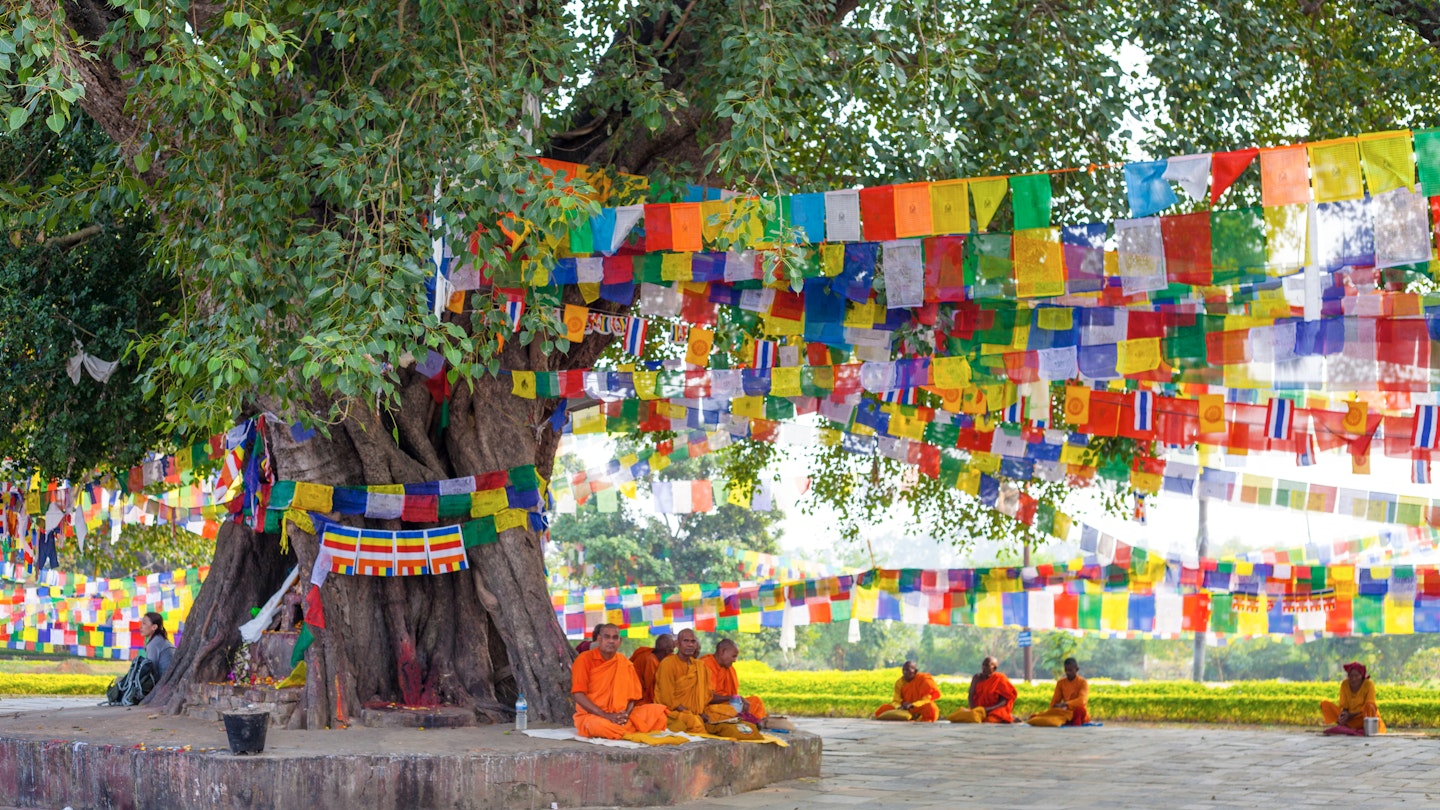Discover Lumbini: The Birthplace of the Buddha
Lumbini is a UNESCO World Heritage Site that houses several monuments of Buddhist and historical significance. Despite being somewhat distant from Nepal’s popular Kathmandu-Pokhara-Chitwan golden triangle, Lumbini draws numerous visitors—primarily pilgrims—seeking to walk in the footsteps of its most famous resident from over 2500 years ago.
The 22,288-km-sq (8605-sq-mile) region is divided into three major territories: the Sacred Garden, the Monastic Zone, and the Cultural Centre and New Lumbini village. Among other structures, it contains remains of viharas (monastic living quarters), stupas, and contemporary monasteries built by various countries as a homage to the Buddha.
When Should You Go to Lumbini?
The best time to visit Lumbini is between October and December, right after monsoon and before the winter chill sets in. The monsoon season brings constant rains that restrict movement, and the deep winters of January and February can leave landmarks hidden in fog for a significant portion of the day. Although March and April are pleasant, the elevation of Lumbini (150m or 492ft) means that the summer months of May and June can bring sweltering temperatures of 35–40°C (95–104°F). For those willing to face the heat, visiting during May (or April, depending on the Hindu calendar) allows one to witness the Buddha Jayanti festivities that celebrate the Buddha’s birth.
How Much Time Should You Spend in Lumbini?
A single day is typically sufficient for travelers who wish to simply check off Lumbini from their bucket list. However, a two-day stay is recommended for those desiring a more enriching experience. To delve deeper into not just the monuments, but also Buddhism and its core tenets, consider adding a third day to explore surrounding areas and appreciate the atmosphere that resonates with many, including individuals who define themselves as “spiritual but not religious”. For those interested in comprehensively exploring the Gautam Buddha circuit and adjacent districts comprising the Greater Lumbini area, a week is advisable.
Is It Easy to Get Around in Lumbini?
The closest airport is Gautam Buddha International Airport in Bhairahawa, approximately 18km (11 miles) from Lumbini Garden, and can be reached conveniently by taxi in about half an hour. There are also bus services from Kathmandu, but poor road conditions can make the 10-hour journey quite tedious.
Given Lumbini’s proximity to India, many travelers cross the border here, including backpackers venturing through Varanasi. The recommended route is to take a train to Gorakhpur in Uttar Pradesh, followed by a bus to the border town of Sunauli. Travelers can then cross on foot (or by rickshaw) and take a bus to Lumbini, approximately 36km (22 miles) away.
Within Lumbini, cycling is the best way to explore the sites. Begin your journey at the Tourist Information Centre for an overview of the site, starting from the entrance at Gate no 1. Alternatively, consider the increasingly popular e-rickshaw tours.
Top Things to Do in Lumbini
Walk Around the Sacred Garden
The Sacred Garden is the most significant area for most visitors, believed to be the site of the Buddha’s birth. It centers around the Maya Devi Temple, named after the queen who stopped here to give birth to the prince destined to renounce his kingdom. Near the temple is the Ashoka Pillar, erected in the third century, which commemorates the Buddha’s birth through an inscription, placed nearly 375 years after his life by Mauryan emperor Ashoka the Great.
Cycle Through Lumbini’s Lanes
Exploring Lumbini by bicycle allows for a flexible pace to admire the sites while taking time to appreciate the tranquility of the area.
Climb Up the World Peace Pagoda
The World Peace Pagoda, a striking white structure built by Japan, is a notable feature of the Monastic Zone. Visitors can ascend to enjoy spectacular views and witness statues of the Buddha in various postures.
Engage with Monks and Philosophers
It is common to approach a monk in Lumbini who is willing to discuss life, Buddhist philosophy, and more. For a deeper historical insight, engaging a local Buddhist scholar for a personalized tour can offer a unique perspective.
Boat Down the Central Canal
Experience Lumbini from the water by taking a boat down the Central Canal, which connects the Sacred Garden with the Eternal Flame, a site that has been burning since 1986. Round trips and one-way options are available, allowing for views of the serene surrounding landscapes.
Explore Beyond Lumbini
While Lumbini holds significant cultural value, nearby areas also marked important moments in the Buddha’s life. Devadaha, 57km (35 miles) distant, is the birthplace of Buddha’s mother, Queens Maya. Tilaurakot, the paternal home of Siddhartha, features remnants of a historic walled city, while Kudan, where Buddha’s son Rahul was ordained, reveals archaeological insights worth exploring in a single-day excursion from Lumbini.
What Should You Wear in Lumbini?
Though there is no official dress code, dressing modestly is respectful when visiting monasteries. Visitors should expect to remove shoes upon entering the Maya Devi Temple.
How Much Money Do You Need for Lumbini? (NPR)
Nepal is renowned for being a budget-friendly destination, and Lumbini is no exception:
- Budget Guesthouse: Rs 1500 (US$11)
- Hotel for Two: Rs 5000 (US$38)
- Entrance Fee for Non-SAARC Foreign Nationals: Rs 700 (US$5)
- Bicycle Rental for a Full Day: Rs 500 (US$4)
- E-Rickshaw Tour: Rs 500 (US$4) per hour (approximately 4 hours for main sights)
- Round Trip Boat Ride: Rs 150 (US$1)
- Car Hire for a Day Trip (8 hours): Rs 7500 (US$55)
- Coffee: Under Rs 20 (US$0.50)
- Sandwich: Rs 150 (US$1)
- Beer (Pint): Rs 500 (US$3)
- Meal for Two at a Top-End Hotel: Rs 2500 (US$18)
When interacting with monks, a small donation of Rs 100 is appreciated. Alternatively, donations in the form of packaged snacks and drinks are welcomed by locals.
This article was first published on June 6, 2018, and updated on October 2, 2024.




